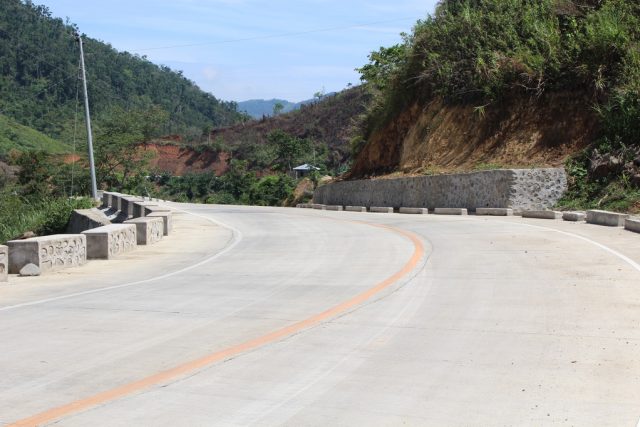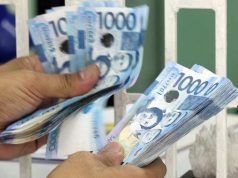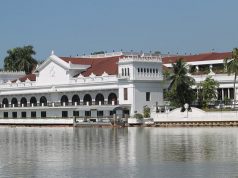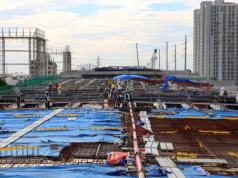
MANILA – Government disbursements on infrastructure and other capital outlays surged by a fourth as the third quarter began, marking the third straight month of double-digit growth, the Budget department said over the weekend.
State infrastructure spending and other capital outlays grew by 25% to P48.4 billion in July, from the P38.7 billion recorded in the same month last year. It was, however, 6.7% smaller than June’s P51.9 billion.
An assessment of the Department of Budget and Management that was e-mailed to journalists last weekend attributed July’s year-on-year increment to “the implementation of flood control, road improvement and road widening projects of the Department of Public Works and Highways (DPWH).”
Also cited were the acquisition of naval and air defense equipment under the Armed Forces of the Philippines modernization program; equipment and infrastructure outlays under the Department of Health’s (DoH) Health Facilities Enhancement Program; as well as payments for the right-of-way acquisition for the ongoing Southwest Integrated Transport System project and civil works for the Light Rail Transit-2 East Extension project that will stretch this line by 4 kilometers from Barangay Santolan in Pasig City to Masinag in Antipolo City.
Infrastructure and other capital outlays grew by 11.1% uptick to P297.5 billion as of July from the P267.7 billion recorded in the comparable seven months of 2016.
The year-to-date tally is equivalent to 61.35% of the P484.9-billion infrastructure and other capital outlays programmed for this year, as indicated in the 2018 Budget of Expenditures and Sources of Financing.
Sustained year-on-year growth of these expenditures in those seven months was likewise attributed to road widening and improvement projects, military modernization, as well as improvement of health care facilities, state universities and colleges.
Budget Secretary Benjamin E. Diokno had said in July that state expenditures are now “on the dot” as a result of closer monitoring and follow-up of the government’s five biggest infrastructure spenders, namely: the departments of Agriculture, Education, Transportation, as well as DoH and DPWH.
“The growth of disbursements in July this year, which is double the growth for the same month in 2016, is a positive indication that the government has gotten past the adjustment stage or transition period,” DBM said in its report, noting that July last year saw infrastructure and other capital expenditures “almost flat” since it marked the first month of the six-year term of President Rodrigo R. Duterte.
“This gives us optimism that the growth of government spending will be sustained until the end of the year,” it added.
“Line agencies still have around five more months to expend these allotments which could further increase disbursement levels.”
DBM also noted that, historically, disbursements pick up in the third month of each quarter “in view of the timing and processing of payments, as well as the tendency of agencies to speed up utilization of cash allocations before they lapse at the last working day of… the quarter.”
Such spending also picks up every fourth quarter as government accelerates its implementation of projects and programs ahead of the closing of books at the end of the year.
PROMISING
Government spending will likely have a bigger contribution to overall economic growth this year amid signs that disbursements have picked up faster than expected, a global bank said, cementing an above-six percent growth for the Philippines.
Economists at DBS Bank now expect overall public spending to pick up by 6.4% this year, sharply faster than the 2.4% previously forecast as the global bank saw expenditures surge by 7.1% in the second quarter.
“The pace of monthly budget spending has accelerated after a slow start of the year,” the bank analysts said in their fourth-quarter report.
“Budget spending grew 13.6% (year-on-year) in 2Q17 and remains in double digit as of July 2017,” they noted.
“In the year up to July 2017, budget spending grew a pretty strong 9.3%, more than the 7.8% growth recorded in revenue collection.”
These prospects would likely give a lift to overall gross domestic product (GDP) growth, which DBS sees climbing by at least 6.4% this year and 6.7% by 2018.
“Growth momentum remains pretty strong, given supportive private consumption growth,” DBS said.
“There are some upside risks to our forecasts, stemming from the government’s infrastructure drive.”
Philippine GDP growth picked up to 6.5% in the second quarter from the 6.4% recorded from January to March.
The year-to-date 6.45% approximates the government’s 6.5-7.5% full-year growth goal for 2017.
Economic managers have said that the economy will likely see faster growth this semester as more infrastructure projects are rolled out.
DBS economists added that consumer spending will remain a key growth driver despite normalization from the extra boost from the general elections last year.
Investments will also lift growth prospects further despite easing to around 10%, coming from a peak of 20% over the last two years.
Exports are expected to sustain robust expansion at 16.5% this year, even as this pace will continue to be outpaced by import growth riding an aggressive infrastructure development program that will see some P8.44 trillion in government funds spent by 2022, when Mr. Duterte ends his term.
This will place the current account in deficit, equivalent to 0.6% of GDP, but unlikely to pressure on the Bangko Sentral ng Pilipinas (BSP) to raise interest rates just yet.
Inflation is projected to average 2.9% for the entire year, higher than the 1.8% logged in 2016 but below BSP’s 3.2% forecast for 2017. “The softer-than-expected inflation in June-July 2017 has provided room for the BSP to refrain from raising rates. But inflation is slowly gaining momentum yet again, even if it is set to remain well within the 2-4% target for now,” DBS said, adding that it expects one rate hike from the BSP this quarter and another in 2018.









